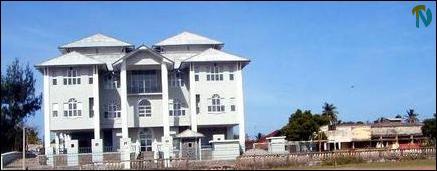IDA funds modern Court complex for Jaffna
[TamilNet, Saturday, 10 July 2004, 00:37 GMT]
On July 14 Wednesday Sri Lanka's Chief Justice Mr.Sarath N.Silva will lay the foundation stone for the modern court complex in Jaffna to be constructed at a cost of 160 million rupees with financial assistance from the International Development Agency (IDA) of the World Bank under the Legal and Judicial Reforms Project. The construction work would be completed in October 2005, sources said.
 |
| New Trinco Court Complex
|
Justice Ministry Secretary Mr.S.K. Gamlath, Judicial Service Commission
Secretary Mr.D.C.Jayatilaka, members of Law Reform Commission and World
Bank officials, will accompany the Chief Justice to Jaffna.
Jaffna High Court Judge Mr.K.P.S.Varatharajah will preside over the
foundation laying ceremony.
Judges, lawyers, government officials, Jaffna
University Vice Chancellor and representatives of local and international
non-governmental organizations have been invited for the event, sources said.
Mr.Sarath N.Silva will later participate in a meeting scheduled
to be held in Veerasingham Hall where all judicial officials and lawyers of the district will attend, sources said.
Later the Chief Justice is scheduled to visit law courts in Mallakam and Jaffna.
Meanwhile, the modern court complex constructed at a cost about one hundred million rupees in Trincomalee for which the Chief Justice had laid the foundation stone on 15th January last year is almost completed and the opening ceremony is expected to take place in August or September this year,
Justice Ministry sources said.
 Building where Trinco Court sessions are held is seen right to the modern complex
Building where Trinco Court sessions are held is seen right to the modern complexThe three storied Trincomalee court complex has a floor area of 36,210 square feet to accommodate six courts, two High Courts including a Commercial High Court, two Magistrate's courts, a District Court and a Labour Tribunal, sources said.
Currently the Trincomalee Magistrate's Court and District Court function in a century old dilapidated building which was built by the Britishers and used as stable when Sri Lanka was under British rule, sources said.








